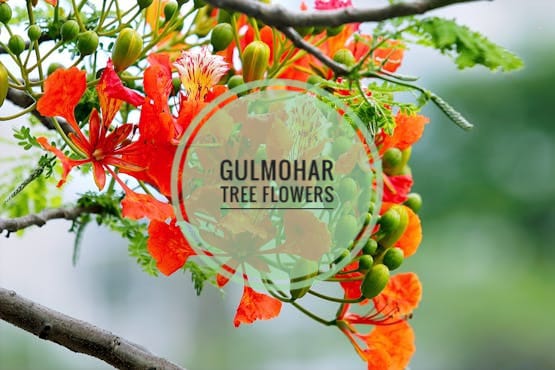The Gulmohar tree, also known as the flame tree, is one of the most spectacular flowering trees in India. With its fiery red-orange blossoms, it adds unmatched beauty to streets, gardens, and parks.
The Gulmohar tree flower is a natural symbol of summer’s vibrancy, combining ornamental value, ecological importance, and unmatched beauty.
Beyond its ornamental appeal, Gulmohar plays an important role in urban landscaping by providing shade and improving greenery in hot climates.
GULMOHAR TREE
| Feature | Details |
| Common Name | Gulmohar, Flame Tree, Royal Poinciana |
| Scientific Name | Delonix regia |
| Family | Fabaceae (Legume family) |
| Native Region | Madagascar |
| Tree Height | 8–15 meters on average |
| Leaves | Fern-like, feathery, bright green |
| Flowers | Fiery red to orange, large clusters |
| Fruit/Pods | Long, dark brown woody pods, up to 60 cm |
| Flowering Season | Late spring to early summer |
| Lifespan | 40–60 years when grown in favorable conditions |

DESCRIPTION
Gulmohar is a medium-sized deciduous tree reaching 8–15 meters in height. Its leaves are feathery and fern-like, giving it a delicate, airy look.
During summer, the tree bursts into clusters of red-orange blossoms that resemble flames. After flowering, it produces long dark brown seed pods that can grow up to 60 centimeters in length.
HISTORY / ORIGIN
The Gulmohar tree is native to Madagascar, where it grows in dry deciduous forests. Its scientific name Delonix regia comes from the Greek words “delos” (visible) and “onyx” (claw), referring to its striking claw-like petals.
The tree was introduced to India during colonial times and quickly gained popularity for its vibrant flowers and fast growth. Today, it is widely planted across tropical and subtropical regions of the world.
NATURAL HABITAT & DISTRIBUTION
In its natural habitat, Gulmohar thrives in dry deciduous forests of Madagascar. In India, it is widely grown in cities, parks and roadsides where it enjoys plenty of sunlight.
The tree adapts well to tropical and subtropical climates. It is also cultivated in Africa, the Caribbean, Southeast Asia and Australia as an ornamental plant.

USES & BENEFITS
The Gulmohar tree is valued mainly for its ornamental beauty but it offers more than just looks. Its dense canopy provides much-needed shade in hot summers, making it a popular roadside tree.
The wood is sometimes used for small construction purposes.
Its flowers and pods are occasionally used in folk medicine, although it is not a major medicinal tree. In urban landscapes, Gulmohar helps reduce the urban heat effect and improves air quality.
GULMOHAR TREE FLOWER
A SUMMER SPECTACLE
The Gulmohar tree flower is one of the most striking sights during summer. With its fiery red, orange, or sometimes golden-yellow blooms, it easily stands out among other tropical trees.
Scientifically called Delonix regia, the Gulmohar is often celebrated as the “Flame of the Forest” because of its blazing canopy when fully covered in flowers.
Streets and gardens glow with color during its peak flowering months, making it a seasonal highlight in many cities.
UNIQUE BEAUTY AND SHAPE
What sets the Gulmohar tree flower apart is its elegant form. Each bloom has five petals, with one larger petal streaked with white or yellow markings, adding a beautiful contrast.
These flowers cluster in large bunches, giving the entire tree a dazzling, umbrella-like display. The blooms last several weeks, and when petals fall, they create a colorful carpet beneath the tree that looks equally stunning.

SYMBOLISM AND GROWING CONDITIONS
The Gulmohar tree flower is admired not only for beauty but also for its cultural presence. In poetry and tradition, it often symbolizes passion, energy, and warmth.
The tree is commonly planted along roadsides, parks, and campuses to provide both shade and charm. It also supports biodiversity by attracting bees, butterflies, and birds.
ECOLOGICAL ROLE
Gulmohar plays an important role in the ecosystem by attracting pollinators like bees, butterflies, and birds during its flowering season. Its wide canopy offers shade for smaller plants and protection for wildlife.
The fallen leaves decompose and enrich the soil, improving fertility. In cities, Gulmohar contributes to controlling dust and reducing pollution levels.

CULTURAL & HISTORICAL SIGNIFICANCE
Although the Gulmohar is not native to India, it has become deeply connected with Indian culture. Its fiery red blossoms symbolize passion and energy, often celebrated in poetry and songs.
Many schools and institutions across India have Gulmohar trees in their campuses, where they are admired for their seasonal beauty. In some regions, the arrival of Gulmohar flowers marks the beginning of summer.
HOW TO GROW & CARE
Growing a Gulmohar tree requires patience, but once established, it thrives with minimal care. The tree prefers well-drained soil and full sunlight. It grows best in tropical and subtropical climates.
Water young plants regularly, but once mature, Gulmohar becomes drought-tolerant. Pruning is important in the early stages to shape the canopy.
Avoid planting too close to buildings since its roots spread wide and may damage foundations.

FAQs
|

Even though it is not native, Gulmohar has become an inseparable part of Indian landscapes, making it truly a flame of the forest.Thanks for reading.
Keep growing, keep exploring, and don’t forget to return here at gardeningbud.com for more plants, tips and gardening wisdom.”
